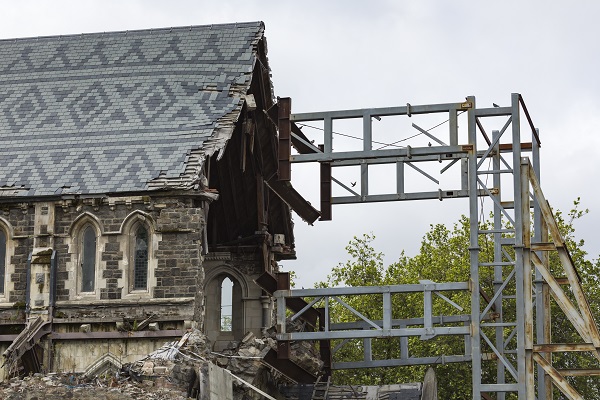We told you so – PPTA on Ombudsmen criticism of post-earthquake school closures

The Post Primary Teachers’ Association (PPTA) has been succinct in its response to a scathing Ombudsman report into the Christchurch education debacle, saying that its position has not changed since the post-earthquake school mergers and closures were announced five years ago.
Union general secretary Michael Stevenson attended the government’s briefings on the closures in September, 2012 – at short notice and with scant information about what was to come. His account of ensuing chaos was recorded in the union’s blog – and this week, PPTA spokesperson Liz Robinson said, “Our opinion has not changed.”
An Ombudsman report released last week slammed the Ministry of Education (MoE) for its handling of Canterbury school mergers and closures after the 2011 earthquakes, leading to a formal apology from the MoE.
The report found significant flaws in the way the ministry engaged with school communities and recommended it work with the education sector to develop a process for closing or merging schools in future.
Here is Mr Stevenson’s blog post:
My view of the Thursday, September 13, education announcements in greater Christchurch
Michael StevensonThe aim of this blog post is to provide clarity for PPTA members around the events of Thursday, September 13, 2012 in Christchurch.
Thursday September 13, 2012 began a week earlier for me. I received an e-mail from someone called Shaping Education asking me to keep the day free. On Tuesday, September 11, a paper invitation arrived by post requesting my presence at the Lincoln Events Centre from 6pm on Thursday. Light refreshments would be served and “ladies” were asked not to wear stilettos.
Tuesday was also the day the rumour mill wound-up. What was the meeting for? Who was going? Will schools be closed? By the end of the day there appeared to be at least four meetings at the Lincoln Events Centre regarding education renewal – 10:00am, 11:30am, 2:00pm and 6:00pm. I guess I am not very important given my 6:00pm time slot.
So Thursday morning arrived and I was up at dawn for my flight to Christchurch. A colleague and I decided we would attend the 10:00am meeting despite Mr or Mrs Shaping Education instructing us to arrive at 6:00pm. The minister and her advisors sat in the row behind me on the plane and seemed quite smug about the day ahead.
Without the benefit of a Crown limo, it was difficult to reach Lincoln by 10:00am. But by 10:10am I was in the hall while the minister gave “the news” to a group of school principals and board chairs whose schools would “rejuvenate”, “consolidate” or “restore”. These words were ministry spin for close, merge or re-build and host another school or two (official explanations at the bottom of this post). The minister was not as smug at this point as she tried to shield herself from loud critiques of the plan, including the public way the school closures and mergers had been delivered. One man stood up and yelled at her in Te Reo. He was demanding a 4pm embargo so those present could inform whānau, students, teachers, parents and others in the school community of the plans. His request seemed reasonable – better those affected hear the news from a school leader instead of the media. I am no communications or media expert, but I would have thought the minister should have announced an embargo before the release of time sensitive information, not halfway through her address. In any case, it was too late. Those present had text message and smart phone technology that was already in use. Mixed emotions followed – some were brave, others angry, and tears flowed.
For the second meeting we were shunted into much larger basketball arena where an audience of 500 sat before ministers Parata and Brownlee, secretary for education Lesley Longstone, and a few other faces I had not seen before. Minister Brownlee spoke first, but only for a short time as he had a DVD to show the crowd. The DVD was not as exciting as minister Brownlee said it would be. A group of pre-school children sung waiata and said how amazing it was to have a brand new “kindy”. The head girl of Aranui High School spoke about how she now loves maths after the earthquake. A man running a hairdressing academy said how wonderful the Government’s Youth Guarantee is.
Minister Parata was next to speak and ordered the media to leave. I still don’t know what made her speech such a secret. If anything, ordering the media out just raised suspicion and created further confusion. Parata explained that New Zealand schools needed to deliver for five out of five learners. This is a slight twist in language from earlier in the year when she described 20 per cent of students as failures and hand-picked a 2010 statistic to describe Christchurch students as underachievers when compared to their Auckland and Wellington counterparts. The minister’s speech continued as she used words like engagement, consultation, working together and success.
Longstone was the third speaker but said nothing noteworthy. She was slightly more critical of educational achievement in greater Christchurch than the minister had been.
Despite closing over a dozen schools, a wholesome lunch with organic soft drinks was provided for guests.
As I drove back to the Christchurch field office my cell phone was buzzing more than normal, so I pulled over to check it. The news website Stuff had published a story stating Avonside Girls’ and Christchurch Girls’ would merge, as would Shirley Boys’ and Christchurch Boys’. This seemed strange for a number of reasons including geography, the schools’ current rolls, education tradition in the city, and the expense of new buildings. Moreover, there had been no mention of the mergers in the meetings I had attended. Self-doubt sunk-in and I started to wonder if I had been fooled by government and ministry spin. Word spread fast and messages of panic leapt through the education community. I received a text message stating reporters were interviewing Shirley Boys’ students about the school’s planned closure. Photographers arrived at Avonside Girls’.
It took 90 minutes to establish the story was false. That was too late for the teachers and students in these schools who thought the end had come. What a shambles.
My third meeting of the day was hosted by the PPTA Canterbury Region Management Committee. While not planned to coincide with the minister’s announcement, the gathering was timely for obvious reasons. Our primary and NZEI comrades were hit harder and we felt for them, but PPTA members didn’t go unscathed with strong proposals for Aranui High School to become a year one to 13 school from 2016, Unlimited to merge with Discovery One, two Kura Kaupapa to combine, and numerous technology teachers impacted by changes in the intermediate school sector. Despite the sad occasion and humble surroundings, the third meeting was by far the best organised and chaired of the day. There was no organic feijoa juice, just real people.
As for the fourth meeting, I think the horse had already bolted by that stage of the day and I didn’t fancy squeezing an extra trip to Lincoln in before my flight home. I heard through the grapevine it wasn’t well attended and the minister had long left Lincoln.
The three documents below probably explain much of the confusion. The first is a multi-coloured document handed to some school principals. The second was the paper work handed out at the 10:00am meeting. The third was circulated as part of a newsletter on Friday 14th September. There are both consistencies and inconsistencies between the three documents.
Multicoloured – State schools summary of renewal proposals
Meeting paperwork – State schools proposed scenarios









